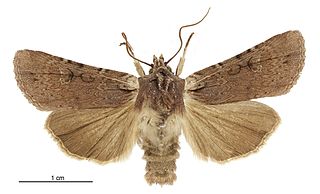
Ichneutica omoplaca is a moth of the family Noctuidae. It is endemic to New Zealand. It is widespread from the Bay of Plenty in the North Island down to Southland in the South Island. Specimens have also been collected from the Auckland Islands. It lives in a variety of habitats including beech forest clearings and tussock grasslands. This species has been recorded that some of the larval hosts of this species include Poa cita, Dactylis glomerata and it has been reared on Plantago lanceolata. The larva is undescribed but pupae have been found in a pine plantation in soil under weeds. Adults of this species are on the wing from October to March. The adult moths are variable in appearance but the diagnostic feature is the pale ochreous to white colouring between the basal streak and the costa which contrasts with the ground colour of the forewing.

Ichneutica scutata is a moth of the family Noctuidae. It is endemic to New Zealand. This species can be found in the southern parts of the North Island as well as the eastern parts of the South Island. It is similar in appearance to I. insignis and I. skelloni but can be distinguished as I. scutata is much paler in appearance. It is likely this species inhabits lowland tussock grasslands as well as coastal dunes although it is not common in inland tussock grasslands. The larvae feed on a variety of herbaceous plants such as Plantago and Convolvulus species, Plagianthus divaricatus. It pupates on soil near its host plants. The adults are on the wing from late March to July.

Ichneutica acontistis is a moth of the family Noctuidae. It is endemic to New Zealand and is found only in the South Island, mainly on the eastern side although not in the Nelson district. This species is similar in appearance to I. paraxysta,I. stulta and I. toroneura. I. acontistis is unlikely to be confused with I. paraxysta as the later is only found in the North Island. I. acontistis can be distinguished from I. stulta as the latter species has a strongly curved forewing edge where as I. acontistis' is straight. I. acontistis can be distinguished from I. toroneura as the former has a dark stroke of colour starting from the base of the forewing that I. toroneura lacks. I. acontistis inhabits tussock grasslands and the larvae of this species feed on species of grass found in the genera Poa, Elymus and Rytidosperma. It pupates under rocks and adults are on the wing from September to January. I. acontistis are attracted to light.

Ichneutica arotis is a moth of the family Noctuidae. It is endemic to New Zealand. This species is found throughout the North and South Islands but has yet to be recorded on Stewart Island. I. arotis is variable in appearance and have been described as having a "northern dark form", a "typical" form and a "swamp" form. Robert Hoare hypothesised that this species may be in the process of evolving into several distinct species. However, as these forms show no difference in antennae or genitalia so, as at 2019, they are not regarded as separate species. Larval hosts include species in the genera Cortaderia and Schoenus as well as Phormium tenax. The caterpillar feeds at night and rests in during the day amongst dead flax leaves. It pupates in a loose cocoon either hidden at the base of a stem of flax or on the ground. The adults of this species is on the wing from September to April. In the North Island there have also been records of adults being on the wing in June to August.
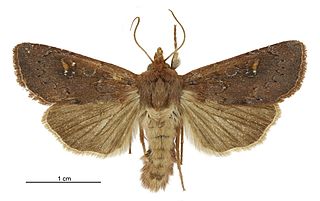
Ichneutica alopa is a moth of the family Noctuidae. It is endemic to New Zealand and is found in the central and southern parts of the North Island as well as in the South Island. It inhabits tussock grasslands and wetlands and can occur at ranges from the alpine zone down to almost sea-level. The life history of this species is unknown as are the host species of its larvae in the wild. Larvae of this species have been raised in captivity on Sphagnum moss as well as on species in the genus Raoulia. Adults of this species are on the wing from late January to April and are attracted to light and to sugar traps. I. alope can be confused with I. agorastis, I. micrastra or I. sapiens but the latter three species can be distinguished externally from I. alope through differences in size, forewing pattern and the antennae of the male of the species.
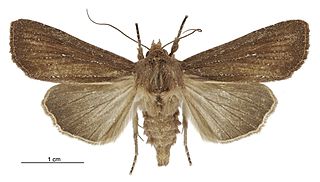
Ichneutica micrastra is a moth of the family Noctuidae. It is endemic to New Zealand. This species has been found only in the North Island and has been collected in the Northland, Auckland, Whanganui and Wellington regions. The preferred habitat of this species is wetlands and heathlands including gum fields in Northland. Adults of this species are on the wing from October to December. The life history of this species is unknown as are the host species of its larvae however it has been hypothesised that the likely larval host is a grass or grass like plant. This species is very similar in appearance to I. phaula and I. sapiens but can be distinguished as a result of differences in male antennae, the shape, colour and size of forewings, the range of the species as well as differences in genital shape.
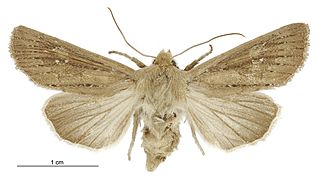
Ichneutica phaula is a moth of the family Noctuidae. It is endemic to New Zealand. It is found only in the South Island in the Nelson district, the eastern side of the South Island and Stewart Island. I. phaula inhabits tussock grasslands and coastal sand dunes. Host species include Ficinia spiralis, Ammophila arenaria, Poa cita and other "tussock grasses". The adults of this species are on the wing from October to December and are attracted to sugar traps. I. phaula is similar in appearance to both I. micastra, with whom it does not share a range, and I. sapiens which differs from I. phaula as I. sapiens is darker and has a more reddish tinge.

Ichneutica unica is a species of moth in the family Noctuidae. It is endemic to New Zealand and is found in the centre of the North Island and throughout the South Island. This moth is very similar in appearance to its close relatives Ichneutica phaula and Ichneutica toroneura. I. phaula can be distinguished as there is a difference in pectinations on the male antennae and I. toroneura can be distinguished as the black vein markings on the forewings is more uniform for that species in comparison to I. unica. I. unica is variable in appearance with the North Island specimens having a darker brown colour on the forewings and having a darker underside of the hindwings. This species inhabits open tussock grassland at various altitudes, coastal dunes, and inland volcanic dunes. Larvae feed on tussock grasses such as Chionochloa pallens and species in the genus Poa. Adult moths are on the wing from November to February and are attracted to both sugar and light traps.
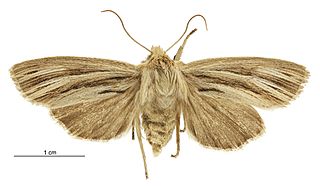
Ichneutica stulta is a moth of the family Noctuidae. It is endemic to New Zealand. This species has only been collected from West Plains and Tuturau in Southland but, as at 2021, no male species appears to exist in collections. I. stulta can resemble I. acontistis but can be distinguished as I. stulta has a strongly curved forewing edge as well as having a discal spot on the underside of the hindwing. I. stulta is also darker than specimens of I. acontistis obtained in the southern parts of the South Island. I. stulta is also very similar in appearance to I. emmersonorum but the later species has darker forewings and is more strongly marked on the thorax. The life history of this species is unknown as are the host species of the larvae but the adults have been recorded as being on the wing from October to December.

Ichneutica steropastis, or the flax notcher moth, is a species of moth in the family Noctuidae. It is endemic to New Zealand and can be found throughout the country from the Three Kings Islands to Stewart Island as well as in the Chatham Islands. The larvae of this species feed on a variety of native and introduced plants however the New Zealand flax is one of the more well known host plants for the larvae of this moth. The larvae are nocturnal, hiding away in the base of the plants and coming out to feed at night. They create a distinctive notch in the leaf when they feed. The adults of this species are on the wing from October to March. Although adult specimens of I. steropastis are relatively easy to recognise they might possibly be confused with I. inscripta, I. theobroma or with darker forms of I. arotis. However I. steropastis can be distinguished as it has a long dark basal forewing streak that these three species lack.

Ichneutica toroneura is a moth of the family Noctuidae. It is endemic to New Zealand. This species is similar to I. unica but can be distinguished from that species by the uniform black vein markings on the forewings of I. toroneura. It is also similar in appearance to I. acontistis but the base of the forewings of I. toroneura lack the dark stripe that can be found on the forewings of I. acontistis. The males of I. toroneura have longer pectinations on their antennae. I. toroneura is found in the centre of southern South Island in the tussock grasslands of Central Otago and the Mackenzie Basin. Larvae feed on tussock grasses Poa cita and Festuca novae-zelandiae. Adults are on the wing from November to January.

Ichneutica paraxysta is a moth of the family Noctuidae. It is endemic to New Zealand. This species is very similar in appearance to its close relative I. acontistis but as the range of the two species do not overlap this is unlikely to cause confusion. I. paraxysta is only found in the North Island at the subalpine zones in the Mount Taranaki region and at Mount Ruapehu. It prefers tussock grassland and shrubland habitat. The life history of this species is unknown as are the host species of its larvae however it has been hypothesised that the larval host plants are species in the genera of Poa and Festuca.

Ichneutica epiastra is a moth of the family Noctuidae. It is endemic to New Zealand and is found throughout the North, South and Stewart Islands. This species prefers open habitats such as wetlands, dunes and forest clearings. Eggs are laid in the summer or autumn and larvae feed during winter and spring. The larval host species are found within the genus Austroderia. The adult moths are on the wing between October and February. Adult I. epiastra can possibly be confused with the similar species I. arotis and I. haedifrontella however there are differences in appearance that enables I. epiastra to be distinguished from these two species. In particular I. epiastra has long sharp-tipped ‘horns' on its head that are diagnostic. The adults of this species appear reluctant to be attracted to light although they do come more frequently to the brighter mercury vapour traps.
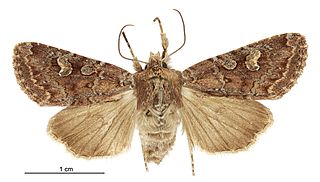
Ichneutica agorastis is a moth of the family Noctuidae. This species is endemic to New Zealand. This moth is similar in appearance to two other species in the genus but can be distinguished through the colour and size of its forewings. This species is found in the South Island and Stewart Island in open habitats in the subalpine zone. However, in Southland I. agorastis can be found down to sea-level. Adult moths are on the wing between January and April. The life history and host species are unknown.

Ichneutica panda is a species of moth in the family Noctuidae. It is endemic to New Zealand and only found in central and southern parts of the South Island. The species has not been collected in Canterbury since the late 1950s and has not been seen at The Wilderness scientific reserve since 1941. This species is similar in appearance to Ichneutica falsidica however I. panda lack or have indistinct black dashes on their edge of their hindwings. I. panda inhabit shrubland from alpine zones down to river terraces and adults are on the wing between December and February. The life history of this species is unknown as is the host species of the larvae.

Ichneutica ceraunias is a moth of the family Noctuidae. It is endemic to New Zealand. This species is found from the central North Island to the bottom of the South Island. Hosts of the larvae are species of Chionochloa and Festuca. This colourful moth is variable in appearance and can be mistaken for Ichneutica dione. Adults are on the wing from October to February.
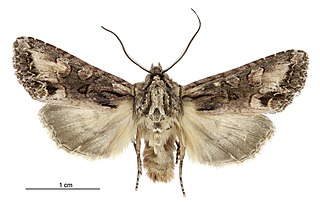
Ichneutica bromias is a moth of the family Noctuidae. This species is endemic to the Chatham Islands of New Zealand where is found on the Chatham, Pitt and Rangatira Islands. This species is similar in appearance to Ichneutica mutans but is darker and duller in its overall appearance. However, as I. mutans is not present in the Chathams this similarity is unlikely to cause confusion. The adults of the species are on the wing from November to March. The life history and the larval host species are unknown.
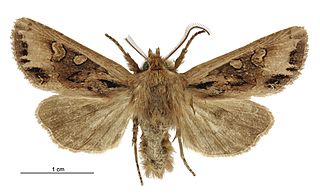
Ichneutica fenwicki is a moth of the family Noctuidae. This species is endemic to New Zealand and is found in the southern parts of the South Island and on Stewart Island. It is a distinctively coloured moth that is unlikely to be confused with closely related species. It is a spring flying moth being on the wing from September to November. The life history and host species of the larvae of I. fenwicki are unknown.
Ichneutica sapiens is a moth of the family Noctuidae. This species is endemic to New Zealand. I. sapiens is found in the central North Island, in the South Island in Westland and also the southern parts of the South Island, and in Stewart Island. This species inhabits wetland habitat but its life history is unknown as are the host species of its larvae. The adult moths are on the wing between December and early January and are attracted to sugar traps and to light. I. sapiens is very similar in appearance to I. micrastra but is a smaller moth with a shorter wingspan, has differently formed antennae and slightly different forewing markings.

Ichneutica paracausta is a moth of the family Noctuidae. This species is endemic to New Zealand. It is found locally in the central North Island, is widespread in the South Island and can also be found in Stewart Island. I. paracausta is variable in colour, but as it has a distinctive black streak on its forewing as well as a wing pattern that is characteristic, I. paracausta is unlikely to be confused with other species. It is present on the North Island volcanic plateau as well as Little Bush Reserve in Hawkes Bay in the North Island as well as in tussock grassland, alpine and subalpine shrubland and in alpine forest. Larvae have been recorded as feeding on grasses, a pupa has been found in a cocoon under the bark of a tree and adult moths are on the wing from October to January.





















